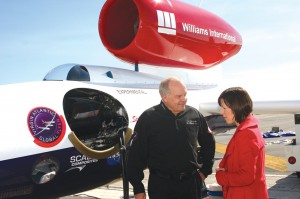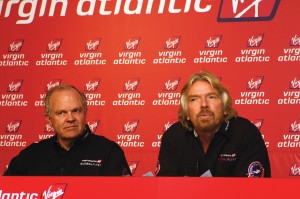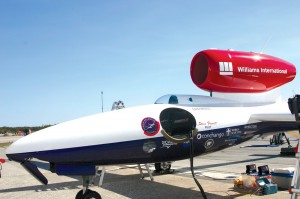By Chuck Weirauch,
Steve Fossett surprised some reporters at the Virgin Atlantic GlobalFlyer pre-takeoff news conference held at Kennedy Space Center Feb. 7 when he said he wasn’t confident that his attempt to break the world solo long-distance aircraft flight record would be successful. As things turned out, his fears were justified right from the beginning.

Steve Fossett points out the mission patch on the fuselage of the Virgin Atlantic GlobalFlyer that accurately depicts how the aircraft looks in flight.
“We’ll be stretching the limits of the airplane with this flight,” Fossett said. “I’m worried, because the risk is much higher than in any other airplane. In fact, it’s probably a risk as high as it might be for any aircraft.”
Virgin Atlantic Airways Chairman Sir Richard Branson, the sponsor of what had been dubbed “The Ultimate Flight,” also expressed some misgivings about the success of the mission. However, his concern was more about the strength of the easterly jet streams aloft that GlobalFlyer would need in order to complete the record-breaking journey.
After the GlobalFlyer and its crew had arrived at KSC from their home base in Salina, Kansas, on Jan. 14, the mission had been delayed for several weeks, not only because of upper atmospheric conditions but also due to unseasonably warm air in Florida. The crew felt that the single-engine turbofan engine atop the airplane’s fuselage would need the extra power it could provide from colder, denser air to lift the fully loaded GlobalFlyer off the runway. The “go” was given for Feb. 8, because early morning temperatures were predicted to be the desired 45-degree Fahrenheit range.
A scary start
Any pilot who witnessed the takeoff from the space center’s 15,000-foot long Shuttle Landing Facility runway, at 7:22 a.m. EST Feb. 8, would most likely have been just as or even more anxious than Fossett. The 4,000-pound GlobalFlyer, burdened with a total of nearly 18,000 pounds of jet fuel in 13 tanks, took up more than 11,000 feet of Runway 33 before rotation.

Steve Fossett discusses his attempt to break the aircraft long-distance flight record alongside the Virgin Atlantic GlobalFlyer.
The aircraft lifted off with a slight stagger and an altitude that barely cleared the tops of scrub pines at the end of the runway. Then the aircraft struck two birds, fortunately causing no damage. A bit shaken but undaunted, Fossett headed east over the Atlantic.
“Takeoff was a bit scary, to say the least,” Fossett later told GlobalFlyer Mission Control. “I had to use most of the runway to get off the ground. This was particularly hairy, because I couldn’t have aborted, even if I had wanted to.”
On top of that, 750 pounds of fuel escaped during takeoff from GlobalFlyer’s fuel venting system. That system had supposedly been fixed after Fossett lost 3,000 pounds of fuel on takeoff during his around-the-world record solo nonstop flight with the same aircraft in March 2005. On the way to cruising altitude of 45,000 feet, the ventilation system for the airplane’s seven-foot-long cockpit broke down, driving interior temperatures to nearly 130 degrees Fahrenheit and forcing Fossett to drink too much of his water supply early on.
More problems
That shaky start set the tone of the entire flight. Always up-to-the-minute with
the latest aviation weather reports and upper atmospheric conditions, GlobalFlyer Mission Control had predicted strong jet streams over the Pacific Ocean, but weak ones over the U.S. and the Atlantic Ocean, as Fossett prepared to complete circumnavigation of the globe. He would need stronger tailwinds throughout the flight if he was ever going to make the anticipated 80-hour, 26,084-mile journey with his landing at Kent International Airport at Manston, England.
The flight could have ended over Bhophal, India, when Fossett experienced unexpected and extremely heavy turbulence at an altitude of 42,000 feet. The graphite/epoxy composite aircraft, with a highly flexible 114-foot wingspan, began to shake and oscillate so much that Fossett was afraid that GlobalFlyer would break apart. Just after he had put on his parachute to get ready to bail out, the airplane passed through the worst of the turbulence.

The symbol for GlobalFlyer sponsor Virgin Atlantic Airways is featured on the fuselage of the record-breaking aircraft.
“I was afraid it was going to break up,” Fossett said. “It was a scary time. I had my parachute on and I was prepared to bail out in case a wing broke.”
The record flight again seemed in jeopardy when Fossett encountered the expected weak jet stream over the U.S. as he neared his goal. In order to save the attempt, his flight plan was modified so that instead of flying up the East Coast to Newfoundland and then across the Atlantic again to the UK, he would head directly eastward from Florida towards his final destination. It was expected that this route change would provide just enough fuel for the aircraft to reach Kent International.
Once over Shannon, Ireland, during mid-afternoon on Feb. 11, Fossett broke the airplane nonstop global flight distance record of 24,986 miles set by Dick Rutan and Jeana Yeager in 1986 aboard Voyager. Shortly thereafter, he beat the 25,361-mile record set by the Breitling Orbiter 3 balloon flown by Bertrand Piccard and Brian Jones in 1999.
Emergency landing
Then, when touchdown at Kent International Airport seemed assured, the generator aboard GlobalFlyer failed, causing loss of all electrical power. Fossett declared a Mayday, calling for an emergency landing.
With his tiny cockpit bubble completely obscured with ice, he set down hard at Bournemouth Airport, blowing out the two main landing gear tires in the process. Finally, after 76 hours, 45 minutes, the harrowing but record-setting flight was over.
In spite of all of the problems and a near-tragic end to his adventure, Fossett and the GlobalFlyer are once again in the record books. The Federation Aeronautique Internationale and the Guinness Book of Records were on hand at Bournemouth Airport to verify that 26,389-mile trek had indeed established a new record for the longest distance nonstop flight for any aircraft.
Motivation
Most people might wonder what would motivate a 61-year-old millionaire to risk his life on such a flight, given that he had less-than-full confidence and perhaps some premonition of disaster concerning the mission. He had certainly already made his mark with his first round-the-world flight in GlobalFlyer, in addition to other record-breaking aviation, ballooning, gliding and sailing achievements. According to Fossett, this time it was more about the aircraft than the pilot.
“We knew that the GlobalFlyer had the capability to fly substantially further than I did on my first around-the-world flight, considering that it flew more than 22,000 miles even after we lost 3,000 pounds of fuel,” Fossett said. “Our goal was to exploit the full capabilities of the aircraft on the Ultimate Flight.”
The GlobalFlyer, Scaled Composite’s Model 311, is a smaller version of the Voyager aircraft Rutan and Yeager flew to establish a world record in 1986. It was built in 2004 for the express purpose of setting a solo nonstop long-distance flight record.
Along with its composite airframe construction, it features a skin of a sandwich of graphite/epoxy and Aramid honeycomb. The company describes the 44-foot-long aircraft as having “a trimaran-like construction” with large twin external booms housing the fuel tanks and landing gear. The engine is a specially designed Williams FJ44 that produces about 3,000 pounds of thrust and is modified for peak fuel efficiency. With its world record established, Fossett and Branson would like to see the GlobalFlyer wind up at the Smithsonian’s National Air & Space Museum.
KSC commercialization

L to R: GlobalFlyer pilot Steve Fossett and Virgin Atlantic Chairman Sir Richard Branson field questions at the Kennedy Space Center preflight press conference.
The GlobalFlyer mission also set somewhat of a mark for KSC. It was the first of what space center officials hope are many more private and commercial ventures that make use of its shuttle runway facilities. With the shuttle program winding down, and with the space vehicle’s replacement destined to be one that would parachute to Earth like the Apollo moon mission capsules, NASA is anxious to see the Shuttle Landing Facility become a hub for aviation-related companies and organizations. The center is also being considered as the site for Florida’s spaceport.
The importance of the GlobalFlyer mission to KSC was highlighted by the attendance of Jim Kennedy, center director, at the preflight news conference. He thanked Branson in particular for bringing a Virgin Atlantic program to the space center. Branson said he hopes that both Virgin Atlantic and Virgin Galactic can bring future projects to KSC.
“The successful GlobalFlyer flight will help us demonstrate how KSC can open its facilities to support commercial aviation development,” said Jim Ball, NASA GlobalFlyer project manager and outreach officer. “We’ve already had a terrific response from the aviation community.”
For more information, visit [http://www.virginatlanticglobalflyer.com] and [http://www.ksc.nasa.gov].
Editor’s note:
Just as we were going to press, Steve Fossett broke yet another long-distance record, his third as the pilot of the Virgin Atlantic GlobalFlyer, when he touched down in Salina, Kan., at 9:06 a.m. CST on March 17. This time, Fossett
shattered the world Absolute Closed Circuit Distance Record set by Dick Rutan and Jeana Yeager of 24,986 miles aboard the Voyager aircraft in December 1986.
The record is for nonstop flights that takeoff and then land at their point of origin.
Fossett flew about 25,300 miles during his 74-hour, third solo trip around the world aboard GlobalFlyer. He took off from Salina at 6:38 a.m. CST on March 14.
Fossett followed the same route that he took in March 2005, but the route added some turns in order to add the distance needed to break the closed circuit record.
This time, flight support was provided by a team of students, faculty and staff from Kansas State University at Salina instead of Virgin Atlantic personnel in Mission Control and overall operations. Fossett now plans to retire GlobalFlyer, improving the possibility that the record-setting airplane will be donated to the Air and Space Museum at the Smithsonian Institution.












